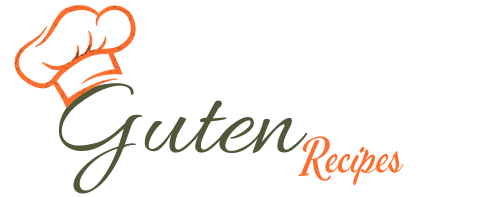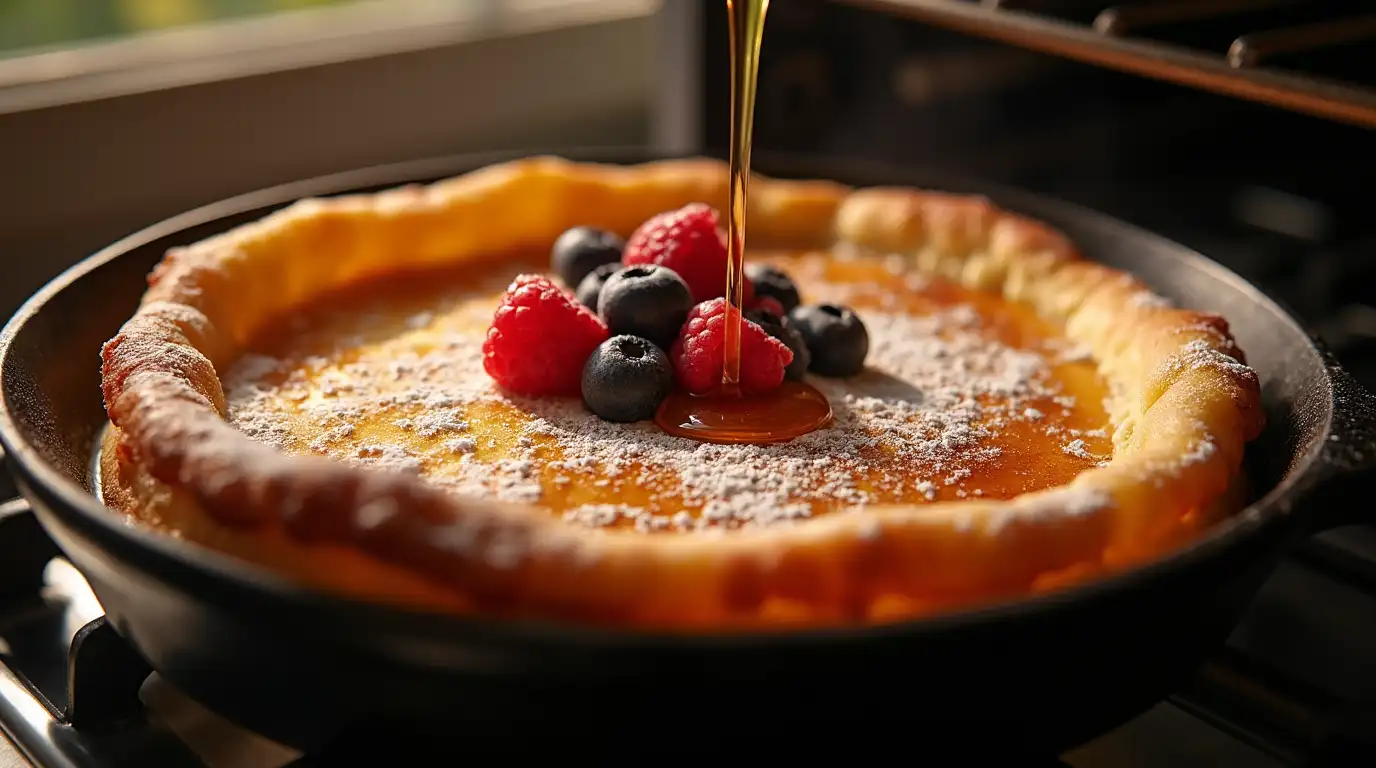A German pancake, often referred to as a Dutch Baby, is a delightful oven-baked dish that puffs up dramatically while cooking, resulting in a light, airy center surrounded by crispy edges. Despite its name, the origins of this pancake are rooted in American cuisine. The term “Dutch Baby” was reportedly coined by one of Victor Manca’s daughters, possibly as a corruption of the German word “Deutsch.”
This pancake is typically baked in a hot cast-iron skillet or ovenproof pan, allowing it to rise impressively before deflating slightly upon removal from the oven. Its versatility makes it suitable for both sweet and savory toppings, making it a favorite for breakfast, brunch, or even dessert.
Key Benefits
Baked German pancakes, also known as Dutch Babies, offer a delightful twist on traditional breakfast options. Here are some key benefits of incorporating them into your culinary repertoire:
High Protein Content: The primary ingredients—eggs and milk—provide a substantial amount of protein, supporting muscle growth and keeping you satiated longer.
Quick and Easy Preparation: With a simple batter and oven baking method, German pancakes require minimal active cooking time, making them ideal for busy mornings.
Versatility: Their neutral flavor profile allows for a wide range of toppings, from sweet options like powdered sugar and fresh fruits to savory choices such as smoked salmon or sautéed vegetables.
Impressive Presentation: The dramatic puffing of the pancake during baking creates an eye-catching dish that’s sure to impress guests.
Healthier Alternative: By baking instead of frying, these pancakes can be a lighter option compared to traditional stovetop versions.
Incorporating baked German pancakes into your breakfast or brunch offerings not only diversifies your menu but also provides a nutritious and visually appealing dish that’s sure to delight.
Ingredients
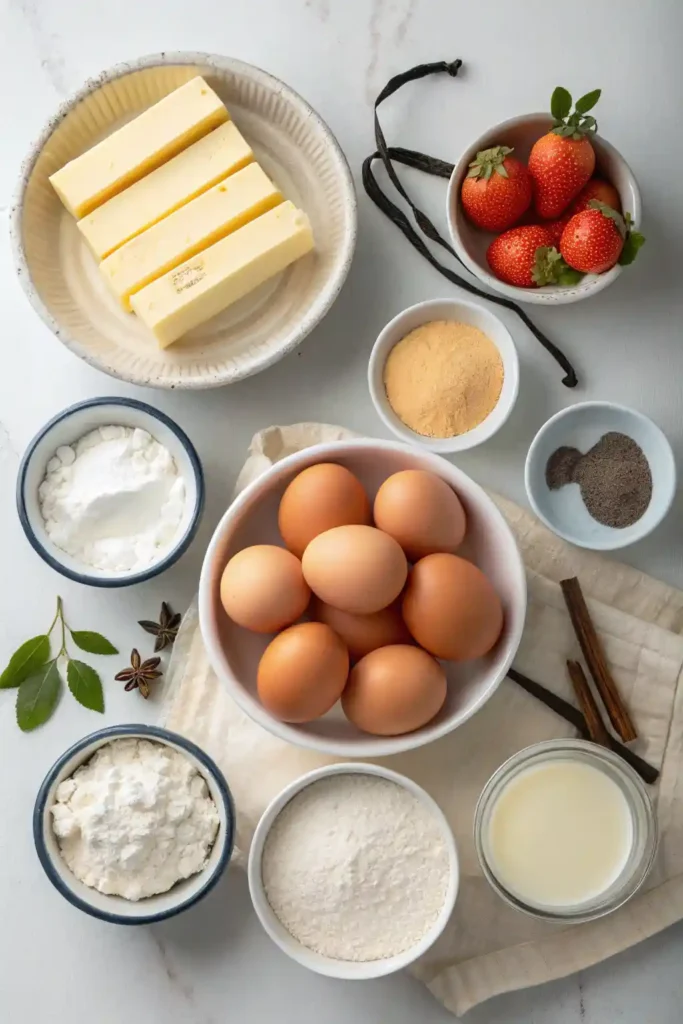
To prepare a delicious baked German pancake, also known as a Dutch Baby, you’ll need the following ingredients:
- Eggs: 4 large
- Milk: 1 cup (preferably whole milk)
- All-Purpose Flour: 1 cup
- Granulated Sugar: 2 tablespoons
- Vanilla Extract: 1 teaspoon
- Salt: ½ teaspoon
- Unsalted Butter: 2 tablespoons
Optional Toppings:
- Powdered Sugar: for dusting
- Fresh Fruits: such as berries, sliced apples, or bananas
- Maple Syrup: for drizzling
- Lemon Wedges: for a citrusy zest
These simple ingredients come together to create a light and airy pancake that’s perfect for breakfast or brunch. The optional toppings allow for customization based on personal preferences, making this dish both versatile and delightful.
Instructions
To craft a unique and delightful baked German pancake, also known as a Dutch Baby, follow these steps:
- Preheat the Oven:
- Set your oven to 425°F (218°C).
- Place a 10-inch cast iron skillet or a 9×13-inch baking dish inside to heat as the oven warms up.
- Prepare the Batter:
- In your blender, mix the eggs, salt,flour, sugar, vanilla extract, and milk .
- Blend the mixture.
- Alternatively, whisk the ingredients in a large bowl until well combined.
- Heat the Butter:
- remove the preheated skillet.
- Add the unsalted butter, allowing it to melt and coat the bottom and sides evenly.
- Add the Batter:
- Pour the prepared batter into the hot, buttered skillet or dish, ensuring it spreads evenly.
- Bake:
- Place the skillet or dish back into the oven.
- Bake for 20-25 minutes, or until the pancake is puffed and the edges turn golden brown.
- Serve Immediately:
- Once baked, remove the pancake from the oven.
- It will deflate slightly as it cools.
- Slice and serve promptly with your choice of toppings, such as powdered sugar, fresh fruits, or maple syrup.
Pro Tips and Variations
To elevate your baked German pancake experience, consider the following expert tips and creative variations:
Pro Tips:
- Use Room Temperature Ingredients: Allow the eggs and milk to reach room temperature before mixing. This ensures a smoother batter and a better rise during baking.
- Preheat the Pan: Heating your skillet or baking dish in the oven before adding the batter helps achieve crispy edges and prevents sticking.
- Avoid Overmixing: Blend the batter just until smooth. Overmixing can develop gluten in the flour, resulting in a tougher texture.
- Serve Immediately: German pancakes deflate quickly after baking. For the best presentation and texture, serve them straight from the oven.
Variations:
- Cinnamon-Apple German Pancake:
- Sauté thinly sliced apples with butter, cinnamon, and a touch of sugar until tender. Arrange the apples in the preheated pan before pouring the batter over them. Bake as usual for a fruity twist.
- Savory Herb and Cheese Pancake:
- Omit the sugar and vanilla from the batter. Add chopped fresh herbs like chives or parsley and grated cheese such as Gruyère or cheddar. This savory version pairs well with a side salad for brunch.
- Berry Burst Pancake:
- Sprinkle a handful of fresh berries (blueberries, raspberries, or blackberries) over the batter immediately after pouring it into the hot pan. The berries will bake into the pancake, adding bursts of flavor.
- Chocolate Chip Pancake:
- Fold semi-sweet chocolate chips into the batter before baking. Dust the finished pancake with powdered sugar and serve with whipped cream for a dessert-like treat.
- Gluten-Free German Pancake:
- Substitute all-purpose flour with a gluten-free flour blend. Ensure all other ingredients are gluten-free certified. The result is a pancake that’s just as fluffy and delicious.
By incorporating these tips and variations, you can customize the traditional baked German pancake to suit your taste preferences and impress your guests with delightful flavors.
Serving Suggestions
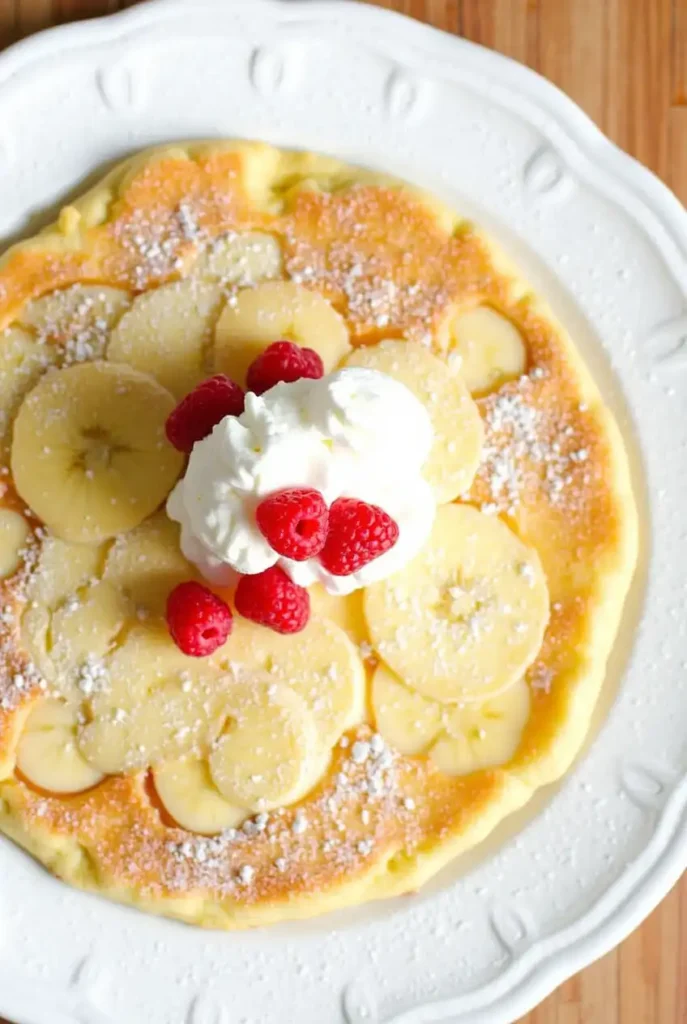
Enhance your baked German pancake experience with these delightful serving ideas:
- Classic Toppings:
- Dust the pancake with powdered sugar and a squeeze of fresh lemon juice for a traditional touch.
- Serve with warm maple syrup or fruit preserves to add sweetness.
- Fresh Fruit Medley:
- Top with a variety of fresh berries, sliced bananas, or sautéed apples to introduce natural flavors and textures.
- Savory Twist:
- For a savory option, omit the sugar and vanilla in the batter.
- Top with smoked salmon, crème fraîche, and chives, or sautéed mushrooms and grated cheese.
- Whipped Cream and Nuts:
- Add a dollop of whipped cream and a sprinkle of toasted nuts, such as almonds or pecans, for added richness and crunch.
- Chocolate Delight:
- Drizzle melted chocolate or Nutella over the pancake.
- Garnish with sliced strawberries or raspberries for a decadent treat.
- Ice Cream Indulgence:
- Pair warm pancake slices with a scoop of vanilla or cinnamon ice cream for a delightful contrast.
- Herb-Infused Butter:
- Serve with melted herb-infused butter, combining flavors like rosemary or thyme, to complement the pancake’s subtle sweetness.
- Honey and Yogurt:
- Drizzle honey over the pancake and add a side of Greek yogurt for a balanced and nutritious option.
- Citrus Zest:
- Sprinkle grated lemon or orange zest on top to add a refreshing aroma and flavor.
- Caramelized Pears:
- Top with caramelized pear slices and a sprinkle of cinnamon for an elegant touch.
Conclusion
Baked German pancakes, also known as Dutch babies, are a delightful and versatile dish that combines simplicity with impressive presentation. Their light, airy texture and golden-brown edges make them a favorite for breakfast, brunch, or dessert. By experimenting with various toppings and fillings, you can tailor this recipe to suit your taste preferences and create a memorable meal for any occasion.
__________________
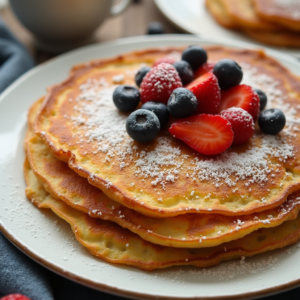
Baked German Pancake
Ingredients
- Eggs: 4 large
- Milk: 1 cup preferably whole milk
- All-Purpose Flour: 1 cup
- Granulated Sugar: 2 tablespoons
- Vanilla Extract: 1 teaspoon
- Salt: ½ teaspoon
- Unsalted Butter: 2 tablespoons
Optional Toppings:
- Powdered Sugar: for dusting
- Fresh Fruits: such as berries sliced apples, or bananas
- Maple Syrup: for drizzling
- Lemon Wedges: for a citrusy zest
Instructions
Preheat the Oven:
- Set your oven to 425°F (218°C).
- Place a 10-inch cast iron skillet or a 9×13-inch baking dish inside to heat as the oven warms up.
Prepare the Batter:
- In your blender, mix the eggs, salt,flour, sugar, vanilla extract, and milk .
- Blend the mixture.
- Alternatively, whisk the ingredients in a large bowl until well combined.
Heat the Butter:
- remove the preheated skillet.
- Add the unsalted butter, allowing it to melt and coat the bottom and sides evenly.
Add the Batter:
- Pour the prepared batter into the hot, buttered skillet or dish, ensuring it spreads evenly.
Bake:
- Place the skillet or dish back into the oven.
- Bake for 20-25 minutes, or until the pancake is puffed and the edges turn golden brown.
Serve Immediately:
- Once baked, remove the pancake from the oven.
- It will deflate slightly as it cools.
- Slice and serve promptly with your choice of toppings, such as powdered sugar, fresh fruits, or maple syrup.
Notes
- Calories: 170 kcal
- Total Fat: 8 g
- Saturated Fat: 3.27 g
- Cholesterol: 193.5 mg
- Sodium: 139 mg
- Potassium: 144 mg
- Total Carbohydrates: 14.17 g
- Dietary Fiber: 0.33 g
- Sugars: 2 g
- Protein: 9.33 g
- Vitamin A: 131.05 mcg
- Calcium: 71.83 mg
- Iron: 1.39 mg
FAQs
How long are German pancakes good in the fridge?
Cool Completely: Before storing, allow the pancakes to cool to room temperature.
Use Airtight Storage: Place them in airtight containers or tightly wrap them in plastic wrap to prevent moisture loss and absorption of other odors.
Avoid Toppings: Store pancakes without toppings to preserve their texture; add toppings fresh when reheating.
Why are my German pancakes not fluffy?
Proper Preheating: Ensure both your oven and the skillet are preheated. Pouring the batter into a cold pan can prevent the pancake from puffing up.
Correct Oven Temperature: Baking at the right temperature is crucial. An oven that’s too cool won’t generate the steam needed for rising, while an overly hot oven can cook the bottom too quickly, leading to a flat top.
Batter Consistency: Overmixing the batter can incorporate too much air, resulting in a dense pancake. Mix until just combined.
Fresh Leavening Agents: Ensure your baking powder is fresh. Expired leavening agents can lead to flat pancakes.
How much protein is in German pancakes?
Incorporate Protein-Rich Ingredients: Add-ins like Greek yogurt, cottage cheese, or protein powder can boost protein levels.
Use Whole Eggs: Using whole eggs instead of just egg whites adds more protein.
Choose Whole Grain Flours: Whole wheat or other whole grain flours contain more protein than refined flours.
How to eat a German pancake?
Traditional Style: Slice and serve warm with a dusting of powdered sugar and a squeeze of fresh lemon juice.
With Syrups and Sauces: Drizzle with maple syrup, berry compote, or chocolate sauce.
Topped with Fruits and Nuts: Add fresh berries, sliced bananas, or toasted nuts for added texture and flavor.
Savory Option: Top with sautéed vegetables, cheese, or smoked salmon for a savory twist.
Enjoy your German pancake immediately after baking to experience its signature puffed texture.
